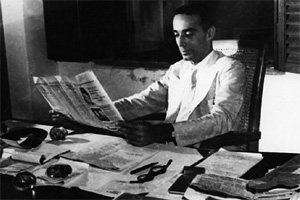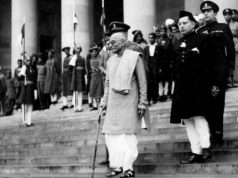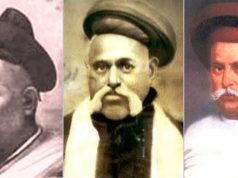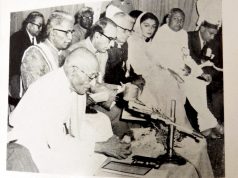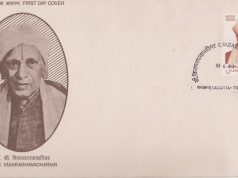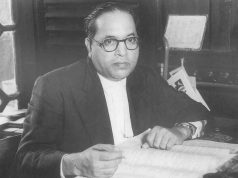The forgotten politician Minoo Masani’s illustrious public career was an exercise in collaboration and confrontation with the other leading Indian nationalist figures. Himself one of the founding fathers of modern India, Minoo was both a nationalist and an internationalist in his intellectual pursuits.
As a young admirer of the USSR experiment and an advocate of democratic socialism, Minoo worked with Jayaprakash Narayan and Nehru to turn Congress towards the left in the 1930s. His active leadership of Congress Socialist Party (CSP) turned both Sardar Patel and C Rajagopalachari against him.
Later in the 1950s though, Minoo Masani would collaborate with JP, Patel, and Rajaji to counter the spread of communism and Nehruvian socialist policies. Masani’s transition from an admirer of the Bolshevik Russia to the propagator of market liberalism in India reflects his pragmatism and open-mindedness, traits rarely found in most intellectuals and politicians.
Soviet Admiration and Communist Leanings –
Minoo Masani’s tryst with politics began during his stint at the London School of Economics. There, he came in contact with Harold Laski and V Krishna Menon; dabbled in student politics as a Labour member; and visited the Soviet Union. Masani admitted to learning more about politics in LSE than many Indian politicians would do in a lifetime.
While Moscow was a great improvement, Masani found Leningrad a shadow of its former self while visiting USSR in 1927. After his return, an impressed Masani wrote a series of articles for the Bombay Chronicles and advocated the USSR as a model for a free India to emulate. In his zeal, he even urged Pandit Nehru to visit the Soviet Union when the two met in London in 1927.
Minoo Masani’s second visit to USSR would come in 1935 as a member of the CSP to foster a deal with the Soviet Communists. Soviet Sidelights, his book on the Russian experience, paid a glowing tribute to the Soviet achievements. Later, in retrospect, he would call it naïve.
Back in India, Masani’s effort to start a socialist front had to wait for Gandhian manoeuvring. The failure of the first Roundtable talk led Gandhi to revive the civil disobedience movement. Masani also got involved this time and was imprisoned in Nashik in 1932. A group of socialists including JP, Achut Patwardhan, and Ashok Mehta were among the political prisoners in the Nashik jail. Minoo Masani’s discussions with JP paved the way for an anti-imperial socialist outfit within the Congress party. After their release, the Bombay branch of the CSP was formed in 1934.
The CSP positioned itself as a national socialist group within Congress to challenge the programs of both Mahatma Gandhi and the conservative faction. Masani, who was then the Joint Secretary, went on a mission to bring more leaders to the fold. Earlier, in December 1933, he met Nehru in Allahabad and requested him to join the group. Nehru welcomed the formation of the socialist group in Congress.
The radical socialists of Congress also had to face flak from outside and inside the party. CPI, following the Sixth Comintern Congress, labelled them as the social fascist. At the Lucknow Session of Congress in 1936, Rajendra Prasad took a jibe at Nehru and his socialist colleagues for deriving ideas from foreign books, inaccessible to Congress conservatives who came from a humble peasant background.
Sardar Patel also had an intense dislike for the reds. He denounced the Congress socialists as the “sappers and miners of the Communist Party”. The wittiest takedown, however, came from Gandhi himself. In response to Minoo Masani’s socialist agenda, he wrote, “the progressive nationalisation of all the instruments of production, distribution and exchange” was “too sweeping to be admissible. Rabindranath Tagore is an instrument of marvellous production. I do not know that he will submit to be nationalised.”
Socialism Reconsidered and Democratic Planning –
Masani’s distancing from Soviet-style communism was seemingly precipitated by a series of events. In his later writings, he attributed it to the failure of the USSR to deliver material prosperity and the influence of Gandhi.
The internationalist Masani was aware of the Stalinist purges and had criticised it in 1938 in the following words – “dictatorship of the proletariat has degenerated into a personal dictatorship”. He asked his fellow socialists to mobilise world socialist opinion to check further bloodshed. Characteristically, Indian communists, Nehru and JP criticised Minoo Masani for his scathing denouncement of totalitarian communism. By this time, Masani was also making a distinction between his scientific socialism and the sentimental socialism: “The real choice today seems to me to be between scientific socialism and dogmatic or authoritarian socialism.”
Minoo’s criticism of the communist movement was further bolstered by the Communist Party of India’s bid to capture the CSP. Under the United Front strategy of the 7th Communist International, CPI was seeking to collaborate with the CSP, only to use it later for communist ends. Masani published in 1938 the secret communist circular which detailed the tactics for the capture. Ultimately, both JP’s insistence on the Left unity and the Congress vacillation over joining World War II led Masani to resign from CSP and retire from active politics.
In 1956, Masani explained Gandhi’s role in turning him away from communism. Gandhi’s dictum that the end doesn’t justify the means translated into a repudiation of communist insurrections. Moreover, his characterisation of the state as the biggest threat to human liberty helped Masani fix his battles. However, as Minoo Masani’s biographer S V Raju notes, his departure from CSP didn’t turn him into an advocate of liberty. A series of essays on socialism published in the 1940s gives insight into the evolution of Masani as an intellectual shaped by the events around the globe.
Socialism Reconsidered, published in 1944, sought to question four core assumptions of Marxism. Masani, in a candid admission, stressed on the need for self-criticism after 25 years of Bolshevik revolution. The pamphlet though didn’t go down well with Pandit Nehru who was furious at Masani for calling October Revolution “a false dawn”.
The four Marxist assumptions put under test included nationalisation leading to economic democracy; the dictatorship of the proletariat as a temporary transition phase; mobilisation of an international proletariat collective; and socialism as the only alternative to capitalism. On all these counts, the dogmatic doctrine floundered when applied to the real world. Minoo Masani’s desirable version of socialism would combine economic equality with individual liberty and political democracy. The influence of Gandhi was visible in Masani’s advocacy of trusteeship which for him served as a valuable transition technique.
Masani’s conception of planning, as outlined in a 1945 article, sought to combine Big State machinery with individual freedom and private enterprise. His democratic planning was seemingly influenced by FDR’s Big Deal and the Scandinavian social democracy. Gandhi’s agenda of small cottage workshops in the countryside also found a place in the plan. Even though Masani recognised the need to balance planning with freedom, his policy prescriptions (licensing, wage and working condition regulations, price fixation) would have led to the curtailment of economic freedom. India’s socialist regime later implemented many of these ideas resulting in economic inefficiency.
With the publication of his next big idea on the mixed economy in 1947, Minoo Masani seems to have inched closer to liberalism. Delivered as a lecture at the Bombay University, A Plea for a Mixed Economy sought to combine free-market capitalism with a degree of state involvement. The importance of economic growth was recognised as he argued that the “economics of production must take precedence over the economics of distribution”.
He would now oppose the nationalisation of the economy, explain profit in terms of incentive to entrepreneurs, compare the free market in the USA with the communist USSR, and advocate foreign capital inflow to spur industrialisation. The peculiar feature of Minoo Masani’s mixed economy was the three-sector model – nationalised existing sectors barring the basic industry; new Public-Sector Enterprises covering areas left by the free enterprise; and the rest of the economy driven by free markets.
The PSEs were to be managed by a small board of professionals seeking to combine efficiency with welfare. The influential proposal was later adopted under the Nehruvian socialism which, according to Masani, turned ‘mixed economy’ into a ‘mixed-up economy’!
Liberal Dissent and Swatantra Years –
Seemingly the failure of the mixed economy model propelled Masani into the liberal fold. He spent his earlier years on combating communist influence in India rather than a positive articulation of liberal ideas. In response to the communist infiltration of media and cultural outfits, Masani joined hands with JP, Ashok Mehta, and A D Gorwala to form the Indian Committee for Cultural Freedom in 1950. The Committee was affiliated with the Paris based Congress for Cultural Freedom, an American anti-communist advocacy group.
Masani’s anti-communist avatar also made him amenable to Sardar Patel. With the help of Patel in the form of office space in Bombay, a telephone connection and funding, Masani founded Democratic Research Service in November 1950. The Service published pamphlets and Freedom First magazine, both disseminating anti-communist propaganda to the Indian public. In the Communist Party of India: A Short History (1954), Minoo Masani called it a dagger pointed at the heart of Indian democracy.
The 1950s saw Minoo as a lonely liberal voice in parliament railing against the socialist policies of the Nehru government. Masani’s efforts at creating a liberal political front had to wait for the end of the decade. The opportunity came with the Nagpur Resolution of Congress in 1959.
The Congress Socialists’ advocacy of joint cooperative farming was widely interpreted as the state bid to collectivise peasants’ property in emulation of China and the USSR. Sensing an opportunity to create a broad-based coalition of big business, urban middle class, peasant proprietors and big landlords, Minoo Masani persuaded Rajaji to lead the new political party. Rajai, for quite some time, was very critical of state interventionism in his public pronouncements. As political scientist Howard Erdman has argued, the newly minted Swatantra Party had both Forum for Free Enterprise and All India Agriculturists’ Forum as its midwives.
The fact that Swatantra was a coalition of big business, feudal zamindars, princely interests as well as urban middle class and peasant-proprietors had opened it to criticism from the left. Pandit Nehru dismissed the party as belonging to ‘the middle ages of lords, castles and zamindars.’ Never mind the fact that the Party had difficulty in attracting funds from big business who were afraid of the repercussions from the Congress controlled state. In ideological terms as well, the party inherited a diverse lot. Rajaji and KM Munshi were Hindu conservatives; Homi Mody and Minoo Masani were westernised liberals; N G Ranga was the Gandhian peasant leader; the Raja of Ramgarh and Maharani Gayatri Devi represented princely interests.
The Swatantra Party’s electoral career was akin to a short-lived boom and bust cycle. The 1967 election saw it emerging as the single largest opposition party only to be swept aside in the Indira wave of 1971. Masani had skilfully steered party as a General Secretary and then the President. The devastating defeat made Minoo Masani resign from the party presidency and retire from politics altogether.
The sorry demise of Swatantra, however, didn’t put an end to Masani’s liberal activism. He would go on to build and nurture civil society organisations wedded to the liberal cause. DRS winded up after the fall of communism, and the Freedom First shifted focus from anti-communism to positive advocacy of liberalism. The Leslie Sawhny Programme of Training for Democracy was Masani’s effort to train young people in democracy and build a liberal cadre. He also set up the Project for Economic Education in collaboration with the liberal economist B R Shenoy’s Economic Research Centre to disseminate liberal economic ideas in public domain. In Masani’s institution-building drive could be found lessons for Indian liberals of fostering a pro-liberty public opinion.
Zareer Masani, historian and Minoo’s son, has argued that the public discourse in India has recently seen a revival of Rajaji’s legacy while Minoo, the beef-eating, westernised, and atheist Parsi, remains forgotten. I would argue that in Masani, Indian liberals should find a more appropriate icon to emulate. Rajaji, after all, was a self-identified conservative rooted in his Hindu identity. Minoo Masani, in contrast, drew his ideas from the West to shape liberal India.
Read more on the Indian Liberal Tradition
Post Disclaimer
The opinions expressed in this essay are those of the authors. They do not purport to reflect the opinions or views of CCS.

